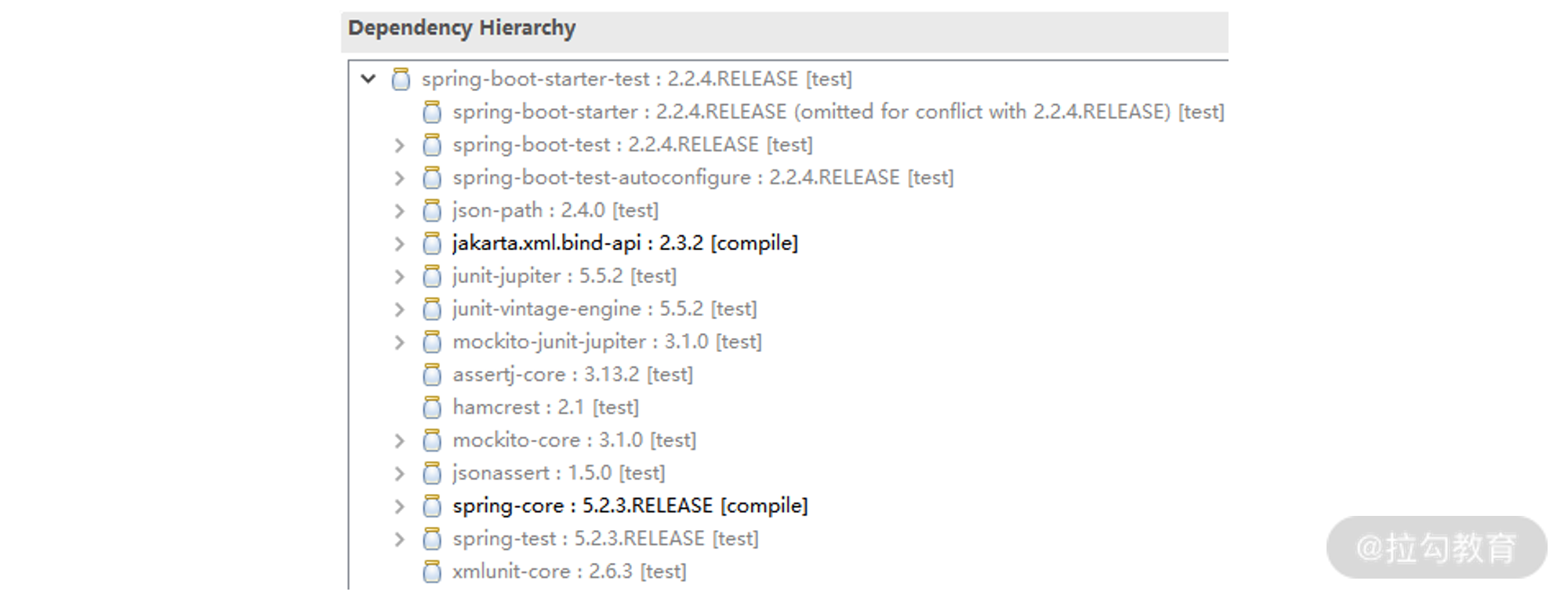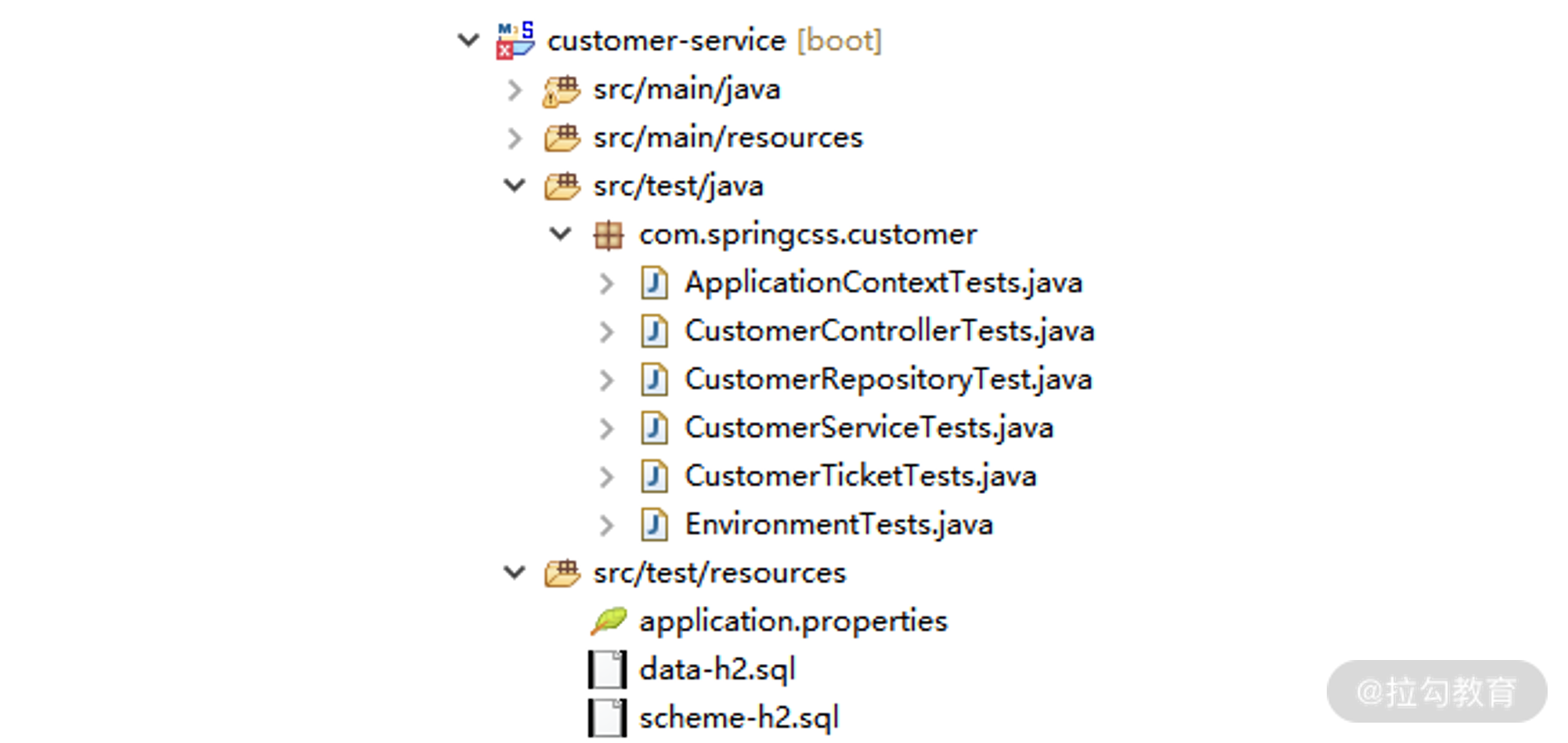23 数据测试:如何使用 Spring 测试数据访问层组件? 作为整个课程最后一部分内容,从这一讲开始,我们将讨论 Spring 提供的测试解决方案。对于 Web 应用程序而言,测试是一个难点,也是经常被忽略的一套技术体系。一个应用程序中涉及数据层、服务层、Web 层,以及各种外部服务之间的交互关系时,我们除了对各层组件的单元测试之外,还需要充分引入集成测试保证服务的正确性和稳定性。
Spring Boot 中的测试解决方案
和 Spring Boot 1.x 版本一样,Spring Boot 2.x 也提供了一个用于测试的 spring-boot-starter-test 组件。
在 Spring Boot 中,集成该组件的方法是在 pom 文件中添加如下所示依赖:
其中,最后一个依赖用于导入与 JUnit 相关的功能组件。
然后,通过 Maven 查看 spring-boot-starter-test 组件的依赖关系,我们可以得到如下所示的组件依赖图:

spring-boot-starter-test 组件的依赖关系图
在《案例驱动:如何剖析一个 Spring Web 应用程序?》中我们提到,Spring Boot 使得编码、配置、部署和监控工作更简单。事实上,Spring Boot 也能让测试工作更加简单。
从上图中可以看到,在代码工程的构建路径中,我们引入了一系列组件初始化测试环境。比如 JUnit、JSON Path、AssertJ、Mockito、Hamcrest 等,这里我们有必要对这些组件进行展开说明。
- JUnit:JUnit 是一款非常流行的基于 Java 语言的单元测试框架,在我们的课程中主要使用该框架作为基础的测试框架。
- JSON Path:类似于 XPath 在 XML 文档中的定位,JSON Path 表达式通常用来检索路径或设置 JSON 文件中的数据。
- AssertJ:AssertJ 是一款强大的流式断言工具,它需要遵守 3A 核心原则,即 Arrange(初始化测试对象或准备测试数据)——> Actor(调用被测方法)——>Assert(执行断言)。
- Mockito:Mockito 是 Java 世界中一款流行的 Mock 测试框架,它主要使用简洁的 API 实现模拟操作。在实施集成测试时,我们将大量使用到这个框架。
- Hamcrest:Hamcrest 提供了一套匹配器(Matcher),其中每个匹配器的设计用于执行特定的比较操作。
- JSONassert:JSONassert 是一款专门针对 JSON 提供的断言框架。
- Spring Test & Spring Boot Test:为 Spring 和 Spring Boot 框架提供的测试工具。
以上组件的依赖关系都是自动导入,我们无须做任何变动。而对于某些特定场景而言,就需要我们手工导入一些组件以满足测试需求,例如引入专用针对测试场景的嵌入式关系型数据库 H2。
测试 Spring Boot 应用程序
接下来,我们将初始化 Spring Boot 应用程序的测试环境,并介绍如何在单个服务内部完成单元测试的方法和技巧。
导入 spring-boot-starter-test 依赖后,我们就可以使用它提供的各项功能应对复杂的测试场景了。
初始化测试环境
对于 Spring Boot 应用程序而言,我们知道其 Bootstrap 类中的 main() 入口将通过 SpringApplication.run() 方法启动 Spring 容器,如下所示的 CustomerApplication 类就是一个典型的 Spring Boot 启动类 : @SpringBootApplication public class CustomerApplication { public static void main(String[] args) { SpringApplication.run(CustomerApplication.class, args); } }
针对上述 Bootstrap 类,我们可以通过编写测试用例的方式,验证 Spring 容器能否正常启动。
为了添加测试用例,我们有必要梳理一下代码的组织结构,梳理完后就呈现了如下图所示的customer-service 工程中代码的基本目录结构。

customer-service 工程代码目录结构
基于 Maven 的默认风格,我们将在 src/test/java 和 src/test/resources 包下添加各种测试用例代码和配置文件,正如上图所示。
打开上图中的 ApplicationContextTests.java 文件,我们可以得到如下所示的测试用例代码: import org.junit.Assert; import org.junit.Test; import org.junit.runner.RunWith; import org.springframework.beans.factory.annotation.Autowired; import org.springframework.boot.test.context.SpringBootTest; import org.springframework.context.ApplicationContext; import org.springframework.test.context.junit4.SpringRunner; @SpringBootTest @RunWith(SpringRunner.class) public class ApplicationContextTests { @Autowired private ApplicationContext applicationContext; @Test public void testContextLoads() throws Throwable { Assert.assertNotNull(this.applicationContext); } }
该代码中的 testContextLoaded() 就是一个有效的测试用例,这里我们可以看到该用例对 Spring 中的 ApplicationContext 作了简单非空验证。
执行该测试用例后,从输出的控制台信息中,我们可以看到 Spring Boot 应用程序被正常启动,同时测试用例本身也会给出执行成功的提示。
上述测试用例虽然简单,但是已经包含了测试 Spring Boot 应用程序的基本代码框架。其中,最重要的是 ApplicationContextTests 类上的 @SpringBootTest 和 @RunWith 注解,对于 Spring Boot 应用程序而言,这两个注解构成了一套完成的测试方案。
接下来我们对这两个注解进行详细展开。
@SpringBootTest 注解
因为 SpringBoot 程序的入口是 Bootstrap 类,所以 SpringBoot 专门提供了一个 @SpringBootTest 注解测试 Bootstrap 类。同时 @SpringBootTest 注解也可以引用 Bootstrap 类的配置,因为所有配置都会通过 Bootstrap 类去加载。
在上面的例子中,我们是通过直接使用 @SpringBootTest 注解提供的默认功能对作为 Bootstrap 类的 Application 类进行测试。而更常见的做法是在 @SpringBootTest 注解中指定该 Bootstrap 类,并设置测试的 Web 环境,如下代码所示。 @SpringBootTest(classes = CustomerApplication.class, webEnvironment = SpringBootTest.WebEnvironment.MOCK)
在以上代码中,@SpringBootTest 注解中的 webEnvironment 可以有四个选项,分别是 MOCK、RANDOM_PORT、DEFINED_PORT 和 NONE。
- MOCK:加载 WebApplicationContext 并提供一个 Mock 的 Servlet 环境,此时内置的 Servlet 容器并没有正式启动。
- RANDOM_PORT:加载 EmbeddedWebApplicationContext 并提供一个真实的 Servlet 环境,然后使用一个随机端口启动内置容器。
- DEFINED_PORT:这个配置也是通过加载 EmbeddedWebApplicationContext 提供一个真实的 Servlet 环境,但使用的是默认端口,如果没有配置端口就使用 8080。
- NONE:加载 ApplicationContext 但并不提供任何真实的 Servlet 环境。
在 Spring Boot 中,@SpringBootTest 注解主要用于测试基于自动配置的 ApplicationContext,它允许我们设置测试上下文中的 Servlet 环境。
在多数场景下,一个真实的 Servlet 环境对于测试而言过于重量级,通过 MOCK 环境则可以缓解这种环境约束所带来的成本和挑战。在 22 讲《服务测试:如何使用Spring测试Web服务层组件?》中,我们将结合 WebEnvironment.MOCK 选项对服务层中的具体功能进行集成测试。
@RunWith 注解与 SpringRunner
在上面的示例中,我们还看到一个由 JUnit 框架提供的 @RunWith 注解,它用于设置测试运行器。例如,我们可以通过 @RunWith(SpringJUnit4ClassRunner.class) 让测试运行于 Spring 测试环境。
虽然这我们指定的是 SpringRunner.class,实际上,SpringRunner 就是 SpringJUnit4ClassRunner 的简化,它允许 JUnit 和 Spring TestContext 整合运行,而 Spring TestContext 则提供了用于测试 Spring 应用程序的各项通用的支持功能。
在后续的测试用例中,我们将大量使用 SpringRunner。
执行测试用例
在这一讲中,我们还将通过代码示例回顾如何使用 JUnit 框架执行单元测试的过程和实践,同时提供验证异常和验证正确性的测试方法。
单元测试的应用场景是一个独立的类,如下所示的 CustomerTicket 类就是一个非常典型的独立类: public class CustomerTicket { private Long id; private Long accountId; private String orderNumber; private String description; private Date createTime; public CustomerTicket(Long accountId, String orderNumber) { super(); Assert.notNull(accountId, “Account Id must not be null”); Assert.notNull(orderNumber, “Order Number must not be null”); Assert.isTrue(orderNumber.length() == 10, “Order Number must be exactly 10 characters”); this.accountId = accountId; this.orderNumber = orderNumber; } … }
从中我们可以看到,该类对客服工单做了封装,并在其构造函数中添加了校验机制。
下面我们先来看看如何对正常场景进行测试。
例如 CustomerTicket 中orderNumber 的长度问题,我们可以使用如下测试用例,通过在构造函数中传入字符串来验证规则的正确性: @RunWith(SpringRunner.class) public class CustomerTicketTests { private static final String ORDER_NUMBER = “Order00001”; @Test public void testOrderNumberIsExactly10Chars() throws Exception { CustomerTicket customerTicket = new CustomerTicket(100L, ORDER_NUMBER); assertThat(customerTicket.getOrderNumber().toString()).isEqualTo(ORDER_NUMBER); } }
执行这个单元测试后,我们就可以看到执行的过程及结果。
而这些单元测试用例只是演示了最基本的测试方式,后续的各种测试机制我们将在此基础上进行扩展和演化。
使用 @DataJpaTest 注解测试数据访问组件
数据需要持久化,接下来我们将从数据持久化的角度出发,讨论如何对 Repository 层进行测试的方法。
首先,我们讨论一下使用关系型数据库的场景,并引入针对 JPA 数据访问技术的 @DataJpaTest 注解。
@DataJpaTest 注解会自动注入各种 Repository 类,并初始化一个内存数据库和及访问该数据库的数据源。在测试场景下,一般我们可以使用 H2 作为内存数据库,并通过 MySQL 实现数据持久化,因此我们需要引入以下所示的 Maven 依赖:
另一方面,我们需要准备数据库 DDL 用于初始化数据库表,并提供 DML 脚本完成数据初始化。其中,schema-mysql.sql 和 data-h2.sql 脚本分别充当了 DDL 和 DML 的作用。
在 customer-service 的 schema-mysql.sql 中包含了 CUSTOMER 表的创建语句,如下代码所示:
DROP TABLE IF EXISTS customerticket; create table customerticket ( id bigint(20) NOT NULL AUTO_INCREMENT, account_id bigint(20) not null, order_number varchar(50) not null, description varchar(100) not null, create_time timestamp not null DEFAULT CURRENT_TIMESTAMP, PRIMARY KEY (id) );
而在 data-h2.sql 中,我们插入了一条测试需要使用的数据,具体的初始化数据过程如下代码所示:
INSERT INTO customerticket (account_id, order_number,description) values (1, ‘Order00001’, ‘ DemoCustomerTicket1’);
接下来是提供具体的 Repository 接口,我们先通过如下所示代码回顾一下 CustomerRepository 接口的定义。
public interface CustomerTicketRepository extends JpaRepository<CustomerTicket, Long> { List
这里存在一个方法名衍生查询 getCustomerTicketByOrderNumber,它会根据 OrderNumber 获取 CustomerTicket。
基于上述 CustomerRepository,我们可以编写如下所示的测试用例:
@RunWith(SpringRunner.class) @DataJpaTest public class CustomerRepositoryTest { @Autowired private TestEntityManager entityManager; @Autowired private CustomerTicketRepository customerTicketRepository; @Test public void testFindCustomerTicketById() throws Exception { this.entityManager.persist(new CustomerTicket(1L, “Order00001”, “DemoCustomerTicket1”, new Date())); CustomerTicket customerTicket = this.customerTicketRepository.getOne(1L); assertThat(customerTicket).isNotNull(); assertThat(customerTicket.getId()).isEqualTo(1L); } @Test public void testFindCustomerTicketByOrderNumber() throws Exception { String orderNumber = “Order00001”; this.entityManager.persist(new CustomerTicket(1L, orderNumber, “DemoCustomerTicket1”, new Date())); this.entityManager.persist(new CustomerTicket(2L, orderNumber, “DemoCustomerTicket2”, new Date())); List
这里可以看到,我们使用了 @DataJpaTest 实现 CustomerRepository 的注入。同时,我们还注意到另一个核心测试组件 TestEntityManager,它的效果相当于不使用真正的 CustomerRepository 完成数据的持久化,从而提供了一种数据与环境之间的隔离机制。
执行这些测试用例后,我们需要关注它们的控制台日志输入,其中核心日志如下所示(为了显示做了简化处理): Hibernate: drop table customer_ticket if exists Hibernate: drop sequence if exists hibernate_sequence Hibernate: create sequence hibernate_sequence start with 1 increment by 1 Hibernate: create table customer_ticket (id bigint not null, account_id bigint, create_time timestamp, description varchar(255), order_number varchar(255), primary key (id)) Hibernate: create table localaccount (id bigint not null, account_code varchar(255), account_name varchar(255), primary key (id)) … Hibernate: call next value for hibernate_sequence Hibernate: call next value for hibernate_sequence Hibernate: insert into customer_ticket (account_id, create_time, description, order_number, id) values (?, ?, ?, ?, ?) Hibernate: insert into customer_ticket (account_id, create_time, description, order_number, id) values (?, ?, ?, ?, ?) Hibernate: select customerti0.id as id1_0, customerti0.account_id as account_2_0, customerti0.create_time as create_t3_0, customerti0.description as descript4_0, customerti0.order_number as order_nu5_0 from customer_ticket customerti0_ where customerti0_.order_number=? … Hibernate: drop table customer_ticket if exists Hibernate: drop sequence if exists hibernate_sequence
从以上日志中,我们不难看出执行各种 SQL 语句的效果,此时你也可以修改这些测试用例,并观察执行结果。
小结与预告
测试是一套独立的技术体系,需要开发人员充分重视且付诸实践,这点对于 Web 应用程序测试而言更是如此。这一讲我们基于 Spring Boot 给出了完整的测试方法和核心注解,并针对关系型数据库给出了数据访问组件的测试过程。
这里给你留一道思考题:在使用 Spring Boot 执行测试用例时,如何基于内存数据库完成数据访问过程的测试?欢迎你在留言区与我交流、互动哦~
介绍完数据库访问测试之后,24 讲我们将讨论如何对 Web 服务层组件进行测试。
参考资料
https://learn.lianglianglee.com/%e4%b8%93%e6%a0%8f/Spring%20Boot%20%e5%ae%9e%e6%88%98%e5%bc%80%e5%8f%91/23%20%20%e6%95%b0%e6%8d%ae%e6%b5%8b%e8%af%95%ef%bc%9a%e5%a6%82%e4%bd%95%e4%bd%bf%e7%94%a8%20Spring%20%e6%b5%8b%e8%af%95%e6%95%b0%e6%8d%ae%e8%ae%bf%e9%97%ae%e5%b1%82%e7%bb%84%e4%bb%b6%ef%bc%9f.md
更多学习
更多实时资讯,前沿技术,生活趣事。尽在【老马啸西风】
交流社群:[交流群信息](https://mp.weixin.qq.com/s/rkSvXxiiLGjl3S-ZOZCr0Q)
